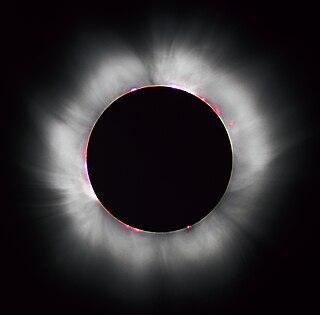| Solar eclipse of August 11, 1999 | |
|---|---|
 Totality from France | |
| Type of eclipse | |
| Nature | Total |
| Gamma | 0.5062 |
| Magnitude | 1.0286 |
| Maximum eclipse | |
| Duration | 143 s (2 min 23 s) |
| Location | Ocnele Mari, Vâlcea County, Romania |
| Coordinates | 45°06′N 24°18′E / 45.1°N 24.3°E |
| Max. width of band | 112 km (70 mi) |
| Times (UTC) | |
| Greatest eclipse | 11:04:09 |
| References | |
| Saros | 145 (21 of 77) |
| Catalog # (SE5000) | 9506 |
A total solar eclipse occurred at the Moon’s ascending node of orbit on Wednesday, August 11, 1999,[1] with a magnitude of 1.0286. A solar eclipse occurs when the Moon passes between the Earth and the Sun, thereby totally or partly obscuring the image of the sun for a viewer on earth. A total solar eclipse occurs when the Moon’s apparent diameter is larger than the Sun’s, blocking all direct sunlight, turning day into night. Totality occurs in a narrow path across Earth’s surface, with the partial solar eclipse visible over a surrounding region thousands of kilometres wide. Occurring about 3.5 days after perigee (on August 8, 1999, at 0:30 UTC), the Moon's apparent diameter was larger.[2]
It was the first total eclipse visible from Europe since July 22, 1990, and the first visible in the United Kingdom since June 29, 1927.
The path of the Moon's shadow began in the Atlantic Ocean and was later traversing the southern United Kingdom, northern France, Belgium, Luxembourg, southern Germany, Austria, Slovenia, Croatia, Hungary, and northern FR Yugoslavia (Vojvodina). The eclipse's maximum was at 11:03 UTC at 45°06′N 24°18′E / 45.1°N 24.3°E in Romania[3][4][5] and it continued across Bulgaria, the Black Sea, Turkey, the northeastern tip of Syria, northern Iraq, Iran, southern Pakistan and Srikakulam in India and ended in the Bay of Bengal. A partial eclipse was visible for parts of eastern Canada, Greenland, Europe, North Africa, the Middle East, Central Asia, South Asia, and China.
- ^ "August 11, 1999 Total Solar Eclipse". timeanddate. Retrieved 10 August 2024.
- ^ "Moon Distances for London, United Kingdom, England". timeanddate. Retrieved 10 August 2024.
- ^ Stavinschi, M., National Seminar" The total solar Eclipse of August, 11, 1999. Interdisciplinary approach, Bucharest, October 15, 1998 in: Romanian Astron. J., vol.8, N.2, p.146 (1998)
- ^ Scientific session " Eclipsa 99", Romanian Astronomical Journal, vol.9, N.1, p.103 (1999)
- ^ Stavinschi, M., The maximum of the last eclipse of the Millenium was in Romania, Romanian Astronomical Journal, , vol.9, N.2, p.109- 114, 1999
